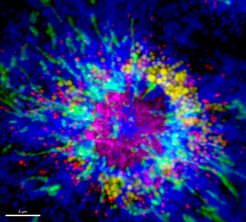Metabolic Organelle Networks in Immunology
Lab Rambold
Immune cell function is instructed by specific rewiring of metabolic programs. Changes in the activity of metabolic pathways are key to sustain energy supply and generate building blocks for the synthesis of macromolecules. Beyond this, metabolites have also been shown to instruct a wide spectrum of cellular processes, including protein function, epigenetic state, pathogen defense and to serve as inter-cellular signaling cue, together illustrating the power of metabolic programming in shaping immune cell function.

In recent years, it has become clear that the majority of metabolic pathways is controlled by the function of different organelles. These discrete membrane-bound compartments are specialized metabolic machines and allow for the separation of often incompatible metabolic processes. For example, lipid metabolism is distributed between the endoplasmic reticulum and mitochondria for lipid synthesis, lipid droplets for storage, mitochondria and peroxisomes for β-oxidation, and lysosomes for lipid hydrolysis and recycling. To integrate the compartmentalized metabolic sub-processes and allow cells to reprogram their metabolism, the activities of these organelles must be coordinated.
Based on mostly pair-wise organelle studies from yeast and non-immune cells, it is becoming clear that many, potentially all, organelles are able to communicate with one another. However, we are still missing clear concepts on which organelles are used to form immune-relevant metabolic networks and how they shape immune cell function when cells adapt their function e.g. during conditions of inflammation and infection. In particular, altering the flow of nutrients and metabolites within a cell requires the coordinated interplay of several organelle systems, which can occur through two principle modes of communication: (1) direct physical contact through special membrane contact sites or organelle fusion to facilitate the transfer of metabolites, and (2) indirect communication between organelle systems through the activation of transcriptional programs or the secretion of bioactive signaling molecules to adapt intra- and inter-cellular organelle activity. Although it is meanwhile established that shifts between metabolic programs and levels of specific metabolites are essential for the regulation of immune cell activity, the functional aspect of interconnected organelle networks and their link to metabolic reprogramming in immune cells and immune disorders has largely been neglected.
In our research, we are particularly interested how organelle-driven metabolic programs/circuits control (a) the activity of individual immune cells under homeostatic conditions, (b) the sensing, detection and elimination of pathogens and (c) the communication within one or between several immune cell populations to coordinate their responses during inflammation and infection.
By employing organelle centric or systems approaches our lab investigates these questions in three categories:
